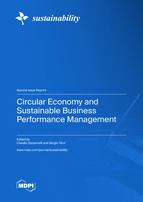Circular Economy and Sustainable Business Performance Management
A special issue of Sustainability (ISSN 2071-1050). This special issue belongs to the section "Economic and Business Aspects of Sustainability".
Deadline for manuscript submissions: closed (28 February 2023) | Viewed by 46552
Special Issue Editors
Interests: product–service systems; circular economy; design for X; product lifecycle management; Industry 4.0; sustainable development goals
Special Issues, Collections and Topics in MDPI journals
Interests: product lifecycle management; Industry 4.0
Special Issues, Collections and Topics in MDPI journals
Special Issue Information
Dear Colleagues,
The journal Sustainability (ISSN 2071-1050, IF 2.576) is currently running a Special Issue entitled “Circular Economy and Sustainable Business Performance Management”, and we are serving as Guest Editors for this issue. We think you could make an excellent contribution based on your expertise.
Today more than ever, the world needs to be considered a finite and limited system, characterized by scarce resources and as a place where restock is not possible in an infinite way. As such, careful resource management needs to be planned and set by the concurrent actions of heterogeneous stakeholders, from policy makers up to academics and industrials, in order to effectively implement circularity and to be able to pursue sustainability in time. The different resources involved along the extended product lifecycle need to be adequately managed through innovative business models and design practices, coupled with reverse logistic and digital technology adoption. So far, several methods have been adopted and combined in different ways to measure and assess the circular performance of a system.
This Special Issue will highlight new opportunities and challenges for Circular Economy and Sustainable Business Performance Management, focusing on technological advancements and management initiatives, including public–private partnerships between stakeholders. We welcome papers on:
- The exploration of how new digital technologies, gathered under the umbrella of Industry 4.0, can support the measurement and analysis of lifecycle data according to the industrial symbiosis level of the system. Since not only single companies but also industrial parks, global supply chains, urban territory, and municipal solid wastes can be taken into account as referring systems of a circular economy performance assessment, the analysis of data coming from an extended and circular supply chain gives the chance to approach very different scenarios in which circular business models have been adopted. This opens the way to also consider, in the measurement of the performance, specific building blocks such as reverse logistics and particular systems conditions;
- The use of design practices to specifically empower product design and development according to specific measurement performances, such as design for X guidelines and checklists, and to give strategic directions to shift the linear lifecycle into a circular one;
- The development of methods and practices able to systematically and practically measure and assess the circularity degree of a given system and to take into account all the heterogeneous resources involved in its lifecycle;
- The development and adoption of methods and approaches, and of a set of related key performance indicators (KPI), suitable for the assessment of the circularity performance in different application fields. These KPIs can deal with the circularity degree of the resources occurring within the product life cycle and can also support the quantification of those that are the economic, environmental, and most of all, social benefits of the CE. These KPIs, from a regulations and reporting perspective, can support the creation of a product certification system related to the circularity of resource flows, internal reporting and benchmarking in companies or support in the creation/enrichment of databases useful for LCA, etc. From a companies’ portfolio circular innovation perspective, they can support not only the decision making process along the design of new products but also the comparison of different versions of the same product based on their degree of circularity;
- The development of a Circular Economy maturity model, based on the definition of a set of KPIs for CE performance assessment, aimed at both defining companies’ level of readiness in terms of circularity and proposing a roadmap to better address CE;
- Future perspectives on Circular Economy and Sustainable Business Performance Management.
Dr. Claudio Sassanelli
Prof. Sergio Terzi
Guest Editors
Manuscript Submission Information
Manuscripts should be submitted online at www.mdpi.com by registering and logging in to this website. Once you are registered, click here to go to the submission form. Manuscripts can be submitted until the deadline. All submissions that pass pre-check are peer-reviewed. Accepted papers will be published continuously in the journal (as soon as accepted) and will be listed together on the special issue website. Research articles, review articles as well as short communications are invited. For planned papers, a title and short abstract (about 100 words) can be sent to the Editorial Office for announcement on this website.
Submitted manuscripts should not have been published previously, nor be under consideration for publication elsewhere (except conference proceedings papers). All manuscripts are thoroughly refereed through a single-blind peer-review process. A guide for authors and other relevant information for submission of manuscripts is available on the Instructions for Authors page. Sustainability is an international peer-reviewed open access semimonthly journal published by MDPI.
Please visit the Instructions for Authors page before submitting a manuscript. The Article Processing Charge (APC) for publication in this open access journal is 2400 CHF (Swiss Francs). Submitted papers should be well formatted and use good English. Authors may use MDPI's English editing service prior to publication or during author revisions.
Keywords
- Circular economy
- Performance assessment
- Industry 4.0
- Industrial symbiosis







